This is a classic mid-sized Lavender. Spikes of fragrant lavender flowers in early summer.
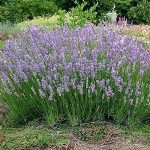
- Munstead Lavender
- 5
- Sun or Part Shade
- 18" x 18"
- Mediterranean


This is a classic mid-sized Lavender. Spikes of fragrant lavender flowers in early summer.
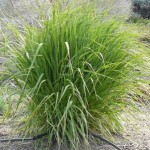
Great Basin Wildrye is the largest native Western bunchgrass. Tall and stately foundation plant for the dry garden. Seed heads in late summer .
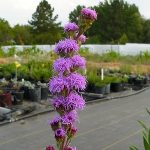
Rocky Mountain Blazing Star produces tall stalks of lavender/purple flowers. This prairie native is a robust grower and does best in fertile soils with infrequent but deep soakings. Nectar plant for Monarch and other butterflies. Excellent cut flower. Firewise.
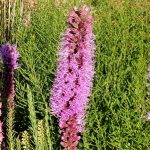
Dense spikes of lavender-pink flowers on tall, thick stems. Great pollinator plant. Prefers dry, sandy soil. Firewise.
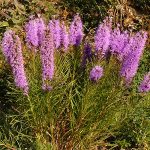
A showy plant for dry gardens or shortgrass meadows, Dotted Gayfeather produces lavender bottlebrushes that bloom from the top down. Deep tuberous taproots account for extreme drought tolerance and long life. Nectar plant for butterflies. Firewise.
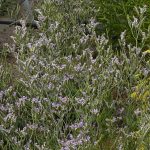
This dwarf, perennial statice produces a bouquet of airy, blue-lavender flowers in mid-summer. The flowers are lovely in dried arrangements.
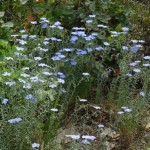
Lewis Flax, a vigorous native that produces masses of cheerful little blue flowers from late spring through mid-summer. Each flower lasts only a day, drops to the ground and is replaced by more the next morning. Charming. Pollinators: bees.
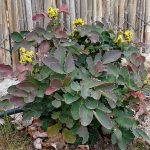
Creeping Oregon Grape is a small, evergreen native shrub. Early flowers are a good pollen source for native insects. Tolerant of both sun and shade, firewise. It can propagate by runners with age. Edible fruit used by native peoples. More information here.
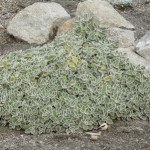
Creeping Horehound has showy, fuzzy leaves edged in silver, carefree ground cover with deep taproot. Especially recommended for shade or part shade areas. Evergreen.
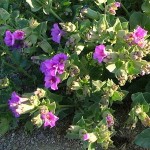
Colorado Four O’Clock dies back to its enormous root in winter. Then, late in the spring, shoots begin to emerge and once the plant starts growing—there’s just no stopping it! It can sprawl far and wide and looks lovely draped over a wall. Long-lived! Firewise. More info here.
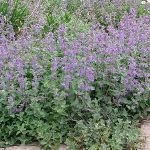
A vigorous, long-blooming catmint. An excellent choice for pollinators. Can seed out aggressively. Firewise.
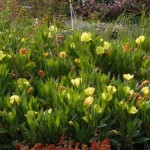
Missouri Evening Primrose grows into mounds of glossy leaves followed by clear yellow blossoms over much of the summer. Plants sprawl widely then die back to the ground in winter. Firewise.
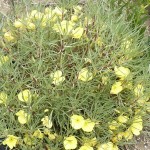
Fremont’s Evening Primrose produces a dazzling display of lemon-yellow flowers in mid-summer. Blooms are tucked in and around the narrow gray- green foliage. Deeply tap-rooted and long-lived. Needs good drainage. Firewise.
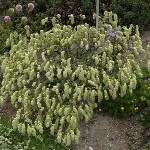
Hopflower Oregano is an outstanding mounding or draping plant, producing hundreds of small lantern-like flowers on wiry stems. Terrific for edging, cascading over walls or filling in between larger plants.
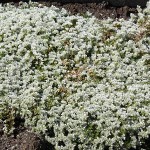
Silver Nailwort is native to the Pyrenees of southern Europe, Silver Nailwort is a tough-as-nails ground cover that very closely resembles Creeping Thyme. Blooming in late spring, the flowers are insignificant, but the white bracts light up the plant for several months. Turns copper in winter then re-greens in spring.
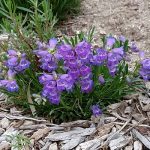
Unusual and rare Penstemon with outstanding landscape value. Low tufts of narrow, dark green leaves persist through the winter then erupt in purple flowers in early spring. Firewise. Choice!
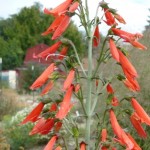
Loose spikes of brilliant scarlet tubular flowers with distinctive ‘bearded’ lip. Tough and long-lived. Attracts hummingbirds. More information here.
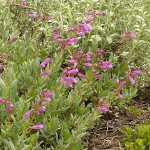
Waxy blue green leaves and large lavender tubular flowers. Semi-woody structure. Prefers part shade. Firewise.
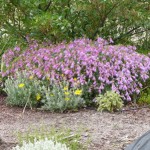
Davidson’s Penstemon is a choice landscape plant with a low, sprawling woody structure that allows it to function like a ground cover. If given some sun protection in winter it will be completely evergreen. Lavender tubular flowers show up in late spring. Likes well-drained soils. Firewise.
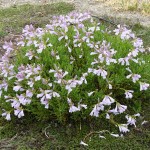
Shrubby Penstemon is an unusual woody, upright, evergreen penstemon with abundant lavender tubular flowers in early summer. Foliage turns soft yellow in autumn with purple-green flower spikelets. Leaves may burn in winter–shade helps. Firewise.
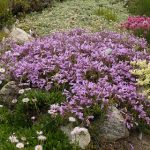
Dwarf Shrubby Penstemon is a compact version of the native Shrubby Penstemon and quite similar to Davidson’s Penstemon. Gorgeous lavender flowers in late spring. Evergreen mounds are beautiful in winter. Charming! Firewise.
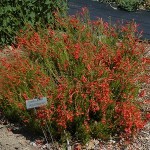
Pineleaf Penstemon has loads of red-orange tubular blooms over expanding clumps of attractive narrow leaves. Stems become woody with age. Evergreen foliage. Firewise. More information here.
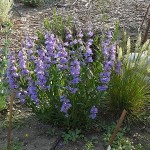
Showy spikes of purple-blue flowers in mid-spring. Flowers are huge and attractive to bees. Firewise.
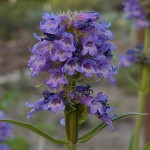
This early blooming penstemon sends up multiple stalks, each with numerous whorls of small tubular flowers. Widespread native. Firewise.
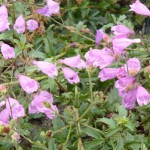
Richardson’s is a wonderful and easy Penstemon for filling in spaces in the garden or tumbling down banks on trailing stems. Unlike most penstemons, this one starts blooming late, producing a charming profusion of rosy purple flowers that lasts from early summer nearly until frost. It re-seeds readily and multiplies in the garden. Firewise.
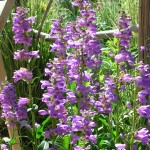
Rocky Mountain Penstemon has violet-blue flower spikes over leathery foliage. Attracts hummingbirds. Long-lived, reliable bloomer. Forms low evergreen clumps, easy and reliable; deadhead for re-bloom. Pollinators: bees. Firewise.
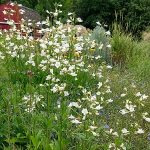
Pure white flowers on tall stems in early summer. This clump-forming penstemon grows wild on dryish soils in prairies and open woods. Attractive to hummingbirds, butterflies and bees.
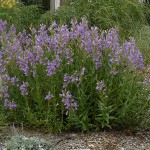
Lovely Penstemon is a vigorous evergreen native penstemon with large, gorgeous tubular lavender flowers in late spring. Cut back seed heads to encourage re-bloom. Pollinators: bees. Firewise.
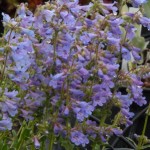
Blue Mist Penstemon or Front Range Penstemon is a dwarf penstemon, native to the plains and foothills of the Eastern Rockies, often growing in large colonies. In late spring, dainty spikes of lavender-blue flowers rise over evergreen rosettes Likes dry, well- drained soil and is well adapted to garden conditions. Firewise.
Shrubby Cinquefoil is a small native shrub covered by small, yellow flowers all summer. Attractive foliage makes this a nice accent plant for sun or partial shade. Attracts bees and butterflies.
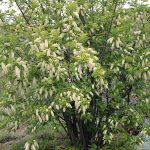
Chokecherry has profuse racemes of white flowers that turn into edible black fruit. Leaves turn deep glossy red in fall. Freely suckering growth form provides good wildlife habitat, especially for birds. Pollinators: butterflies, bees. Firewise.
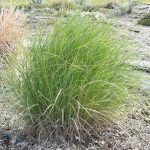
Bluebunch Wheatgrass, a lower Foothills native bunchgrass, greens up early in the spring. Can see out prolifically. Excellent for reclamation, naturalization.
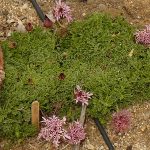
Charming, low-growing rock garden plant or small-scale groundcover. Finely cut evergreen foliage creeps across the ground, sprouting pincushion-like mauve flowers in late spring. Attractive seedhead tufts follow.
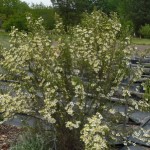
A stout, upright shrub or subtree growing to head-high or higher. Produces many pale yellow, wildrose-type flowers in the spring, each of which produces five feathery plumes with a seed attached. Related to bitterbrush.
The Gambel Oak is a slow-growing large shrub to small tree., often forming a multi-stemmed thickets, Good accent tree with lovely fall color. Glossy leaves; interesting branch patterns in winter. Firewise.
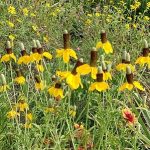
This cheerful wildflower has two forms, one yellow and one red. They both will bloom over a long period in hot, dry summers, attracting bees and butterflies. Great in meadows and other casual landscapes. Will seed around.
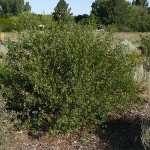
Oakleaf Sumac is a dense, mid-sized to large shrub, excellent foundation plant. Yellow bloom in spring and nice orange-yellow leaf color in fall. Female plants can yield a tart fruit traditionally used to make a lemony drink. Deciduous. Good bird habitat. Unrelated to poison sumac. Firewise. More information here.
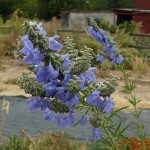
Azure Blue Sage is a tall, late-blooming Salvia. Brilliant blue tubular flowers on slender, arching stems provide dramatic late- season color in the garden. Disappears in winter and comes booming back from the roots in spring. Great late-season food source for bumble bees, honey bees, butterflies and hummingbirds! Tolerates clay. Firewise. More information here.
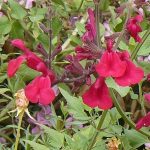
A stunningly beautiful Salvia from high in the mountains of N. Mexico. Attracts hummingbirds, bees. Firewise.
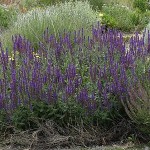
Blue Queen Salvia has spikes of violet-blue flowers in summer; tolerates intense heat and drought. Cut back after bloom for quick re-bloom. Magnet for honeybees and butterflies! Tolerates clay. Firewise.